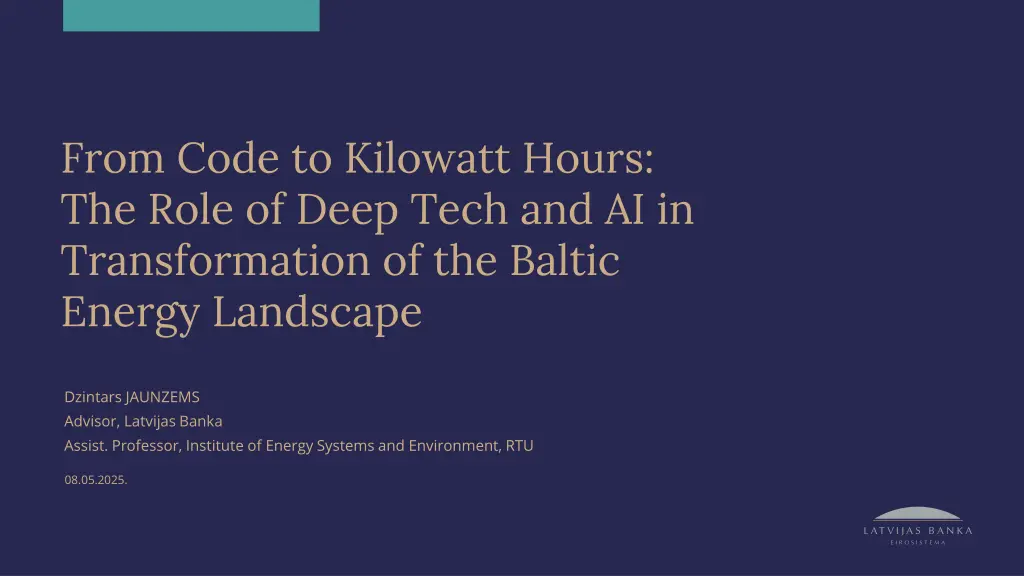
Transformation of Baltic Energy Landscape: Deep Tech & AI Role
Explore the significant shift in Baltic energy systems with a focus on deep tech and AI, examining the impact of renewables, fossil fuels, and key developments in Lithuania, Estonia, and Latvia. Witness the evolution from Soviet rule to open markets amidst geopolitical challenges.
Download Presentation

Please find below an Image/Link to download the presentation.
The content on the website is provided AS IS for your information and personal use only. It may not be sold, licensed, or shared on other websites without obtaining consent from the author. If you encounter any issues during the download, it is possible that the publisher has removed the file from their server.
You are allowed to download the files provided on this website for personal or commercial use, subject to the condition that they are used lawfully. All files are the property of their respective owners.
The content on the website is provided AS IS for your information and personal use only. It may not be sold, licensed, or shared on other websites without obtaining consent from the author.
E N D
Presentation Transcript
From Code to Kilowatt Hours: The Role of Deep Tech and AI in Transformation of the Baltic Energy Landscape Dzintars JAUNZEMS Advisor, Latvijas Banka Assist. Professor, Institute of Energy Systems and Environment, RTU 08.05.2025.
Energy system development & deployment & transition Scale effects: Multi-level, comprehensive, large, and parallel infrastructure Sector-coupling s Long-term effects: Path dependency Lock-in 2 Source: 20200429_D2.1_ScenarioFramework_final.pdf
Brief overview and Current State of the Energy Sector in the Baltic Region
Numerous changes in a very short period. The energy system is just one small aspect of it all. Lithuania, TWh Estonia, TWh Latvia, TWh 160 160 160 140 140 140 120 120 120 100 100 100 80 80 80 60 60 60 40 40 40 20 20 20 0 0 0 2000 1990 1995 2005 2010 2015 2020 2021 2022 2023 2010 1990 1995 2000 2005 2015 2020 2021 2022 2023 1990 1995 2000 2005 2010 2015 2020 2021 2022 2023 Fossil energy Renewables and biofuels Fossil energy Renewables and biofuels Fossil energy Renewables and biofuels 4 Source: Eurostat - https://doi.org/10.2908/NRG_BAL_C
From Phase 0 - The Baltic States under Soviet rule; to Phase 4 open electricity and natural gas market. Russian invasion of Ukraine, no electricity & natural gas import from Russia, synchronization with EU electrical grid. Lithuania, TWh Estonia, TWh Latvia, TWh Phase 4 Phase 0 160 160 160 140 140 140 120 120 120 100 100 100 80 80 80 60 60 60 40 40 40 20 20 20 0 0 0 2000 1990 1995 2005 2010 2015 2020 2021 2022 2023 2010 1990 1995 2000 2005 2015 2020 2021 2022 2023 1990 1995 2000 2005 2010 2015 2020 2021 2022 2023 Fossil energy Renewables and biofuels Fossil energy Renewables and biofuels Fossil energy Renewables and biofuels 5 Source: Eurostat - https://doi.org/10.2908/NRG_BAL_C
LT and EE are leading in Baltics on new renewable electricity capacities. Due to large hydro-power capacities, Latvia due to hydro PP, had better start point. Lithuania, MW Estonia, MW Latvia, MW 5000 2000 700 4500 1800 600 4000 1600 500 3500 1400 3000 1200 400 2500 1000 300 2000 800 1500 600 200 1000 400 100 500 200 0 0 0 2005 2020 Wind 2024 Solar PV 2005 Solar PV 2020 2024 2005 Solar PV 2020 2024 Solar PV (off-grid) Wind Wind IRENA (2025), Renewable Capacity Statistics 2025, International Renewable Energy Agency, Abu Dhabi. 6
Electricity does not dominate in total final consumption. The demand for heat and process heat is at least twice as high. Lithuania (2022) Estonia (2022) Latvia (2022) Heat 12.4% Heat 14% Heat 18% Coal 0% Coal 2% Coal 3.0% Electricity 15.5% Electricity Electricity 21.5% 14% Oil products 36% Oil products 36% Oil products 38.5% Natural gas 18.0% Biofuels and waste Natural gas Natural gas Biofuels and waste Biofuels and waste 12.6% 6% 8% 28% 17% Source: Estonia - Countries & Regions IEA Lithuania - Countries & Regions IEA Latvia - Countries & Regions - IEA 7
Transformation of the Baltic Energy Landscape 8
Smart meters - remote and automated electricity metering Estonia Latvia Lithuania By 2026, for customers consuming more than 1,000 kWh/year From 2026, customers with lower consumption >85% households with smart meters By now: >1 120 000 meters As of 2025, Estonia has achieved 100% smart meter coverage > 700 000 meters Smart electricity meter roll-out completed on May, 2023 >1 000 000 meters 9
Buildings AI systems for real-time monitoring and control AI-enhanced BMS & HVAC (1) Some examples of AI & deep tech in Baltics energy system District heating Digital Twins AI-driven systems to optimize heat distribution: monitor & control Predictive analytics & machine learning algorithms to forecast demand and adjust supply accordingly Renewable energy Integration of AI for analysis (e.g. weather patterns, optimization, location etc.) to improve efficiency and predict maintenance needs 10 Source: 20200429_D2.1_ScenarioFramework_final.pdf
Electricity (DSOs) Remote check of overhead lines (AI + ML) Real-time monitoring with reduced number of sensors Projections of generation & load, damages, development investment & network planning (2) Some examples of AI & deep tech in Baltics energy system Electricity (TSOs) AI and sensor technologies to increase transmission capacity Mobility EV charging modes based on situation on the grid AI to optimize routes and energy consumption 11 Source: 20200429_D2.1_ScenarioFramework_final.pdf
